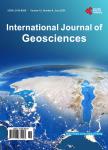Morphometric Analysis of Kakoi River Watershed for Study of Neotectonic Activity Using Geospatial Technology
Morphometric Analysis of Kakoi River Watershed for Study of Neotectonic Activity Using Geospatial Technology作者机构:Centre for Geoinformatics Jamsetji Tata School of Disaster Studies (JTSDS) Tata Institute of Social Sciences Mumbai India
出 版 物:《International Journal of Geosciences》 (地球科学国际期刊(英文))
年 卷 期:2017年第8卷第11期
页 面:1384-1403页
学科分类:1002[医学-临床医学] 100214[医学-肿瘤学] 10[医学]
主 题:Morphometric Geomorphic Indices Neotectonics Geospatial Technology
摘 要:Morphometric analysis is defined as the quantitative measurement of landscape shape. Morphometric studies of a watershed helps the researcher to compare different landform and calculate the geomorphic indices that may be useful for identifying a particular characteristic such as the level of neotectonic activity in a watershed. The present study has been carried out in Kakoi River Watershed which is a part of Lower Subansiri River Basin in Assam. The study area is geo-dynamically unstable region characterized by active faults, continuing crustal movements and complicated structural region which fall under the seismic zone V of India. In recent century, the Lower Suabsiri River Basin has gone tremendous morphological changes due to active tectonics activities. After the Assam Earthquake of 1950, some of the rivers like Subansiri and its tributaries Dirgha, Kadam and Kakoi suddenly changed their channels giving birth to new channels. The present study is to examine the neotectonic domains and the changes of river course. The geomorphic indices such as Hypsometric Integral (HI), Elongation ratio (Re), Asymmetry Factor (AF), Stream-length Gradient Index (SI), Mountain Front Sinuosity (Mfs), Basin shape index (Bs), Ratio of Valley floor width to Valley Height (Vf) and Channel sinuosity (S) etc. have been studied from remote sensing data. The results shows that the study area is under active tectonic area based on Vf (0.301), Rl (0.461), Bs (3.6), Sl (165.73) and other parameters such as S (1.38) and Mfs (2.02) indicated as moderate active tectonic region. Utilization of geospatial technology and remote sensing data in the present study becomes more reliable and helpful in analyzing, monitoring and understanding the landform changes in a watershed.



